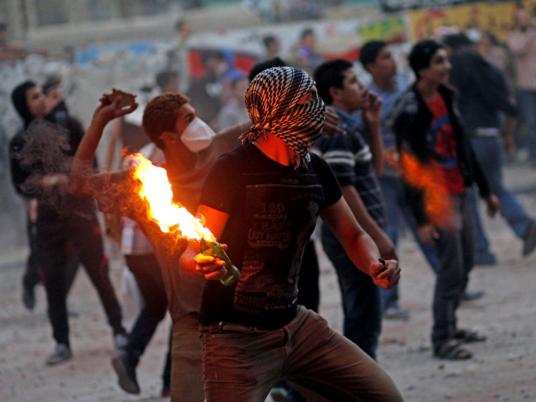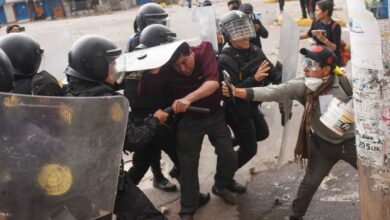
Security forces caused deliberate killing of protesters due to excessive force during the Mohamed Mahmoud clashes in 2011, according to human rights lawyer Mohsen Bahnasy.
In an exclusive interview with Egypt Independent, Bahnasy, a member of a fact-finding committee who investigated Mohamed Mahmoud Street, said security forces used excessively expired tear gas canisters and rubber bullets, firing them directly at sensitive areas of protesters bodies in order to cause grave injury. “[They fired] especially at faces from close range, causing deliberate killings from choking or piercing rubber bullets in sensitive parts,” he said.
Bahnasy says the report, which was commissioned during Morsy’s tenure and has yet to be released, found that both tear gas canisters and rubber bullets were used with the intention of killing rather than dispersing, given they were used in narrow, overcrowded and overpopulated areas.
Contrary to media reports, Bahnasy argues the Mohamed Mahmoud clashes began on 18 November 2011, spanning five consecutive days of intense fighting that left around 50 killed and 800 injured, including serious injuries and permanent disabilities as some protesters lost their eyes from rubber bullets.
For almost four or five days, the narrow Mohamed Mahmoud street witnessed a new suffocating tear gas canisters being shot to kill rather than to disperse. Amidst cloudy, choking clouds, motorcycles were constantly going back and forth carrying the wounded from frontlines to the makeshift emergency clinics. Shooting at eyes was a strangely frequent occurrence as many protesters including Ahmad Harrara, Malek Mostafa and others lost their eyes when snipers were targeting upper parts of bodies.
In March 2013, a Cairo court sentenced First Lieutenant Mahmoud El-Shinnawy — known as the "eye sniper" — to three years in prison for deliberately shooting at protesters’ eyes during the clashes.
Although the Ministry of Interior claims its security forces were merely defending the ministry headquarters, Bahnasy stresses the report showed no evidence that protesters attempted to actually attack the ministry.
On the evening of 20 November, the armed forces, to ease the escalating tensions between policemen and demonstrators, had officially notified the Interior Ministry to retreat back to the ministry headquarters and the armed forces will replace them but the ministry did not implement the order.
“When they were faced by the fact-finding committee members, the ministry offered the armed forces a letter to wash their hands of the killings,” said Bahnasy. “From this date, police and the armed forces became one united front against protesters.”
“Even some doctors were killed while they were rescuing the injured as Central Security kept opening intensive fire at Tahrir Square after forcing protesters to retreat from Mohamed Mahmoud Street,” Bahnasy said.
In Tahrir Square, Dr. Shady al-Nagar treated those wounded by gunfire and rubber bullets at a makeshift emergency care ward in the nearby mosque. “I have seen three people killed and many bone fractures. There is something wrong with these canisters. People are coming are chocked and close to death,” he said.
One ambulance pulled up in front of the mosque and a dozen men, limp and unconscious from teargas, spilled out into the arms of a crowd waiting to rush them to a street side triage station. “We are in a war,” Dr Nagar said. “This is not a protest.”
The ‘iron man’ behind Mohamed Mahmoud clashes
Bahnasy says the man behind the excessive force is no other than the decision-maker in the Interior Ministry, General Samy Seidhom.
As Bahnasy learned more about this figure, he became intrigued about the surrounding circumstances. Seidhom had a high positionin the Interior Ministry during the Mubarak regime and was close to Habib al-Adly, Mubarak’s interior minister. Despite the revolution that ousted Mubarak and the main figures in his regime, he kept not only his seat in power, but was also promoted until he became the ministry’s “iron man” after the revolution.
A 2011 report by Al-Wafd describes Seidhom, who was serving as the minister’s assistant for the security sector, as general of the “Tahrir battle,” in a reference to the Mohamed Mahmoud clashes, and the second most important person in the Interior Ministry after the minister himself as he was in charge of the violations that were committed by security forces during the clashes.
“General Seidhom was a spark of the Mohamed Mahmoud clashes as he was waging verbal attacks on revolutionaries, which escalated to opening fire on them,” the report reads.
Following the 30 June revolution, Seidhom was appointed to a position outside of the Interior Ministry, this time by a decree from interim President Adly Mansour on 13 August as al-Sharqya vice governor, in a surprise move to revolutionaries.
Interior Ministry console the Mohamed Mahmoud martyrs killed by its security forces
The Egyptian Interior Ministry has ironically issued on Sunday a statement to “commemorate” the second anniversary of Mohamed Mahmoud street clashes where the ministry’s soldiers were responsible for killing at least 50 and wounding more than 800 anti-SCAF protesters.
“Interior Ministry gives its condolences to all martyrs of the revolution who watered the tree of national struggle with their pure blood,” the statement reads, warning participants to be on “high alert for infiltrators” who seek to distort the meaning of the memorial.
The statement, the first of its kind from Interior Ministry, was met with an irony from both human rights lawyers and protesters, many of whom were injured in Mohamed Mahmoud clashes.
Bahnasy said the Interior Ministry still has not apologized for its involvement in killing Mohamed Mahmoud protesters. “Just offering condolences is a bare-faced cheek. If they were sincere, they would apologize and admit their responsibility for killing protesters,” he argued.
According to political activist Ahmad Doma, the memorial built at the epicenter of Tahrir square is “an attempt to appease the revolutionists with the goal of outbidding souls of martyrs.”
In the shadow of Mohamed Mahmoud street
Mohamad Mahmoud street, which connects Tahrir Square, where 25 January revolution was centered, to the headquarters of the Interior Ministry, whose brutality was the focal point of the revolution. The street has become a landmark of Egypt’s revolutionaries as it was a nucleus of the Third Square movement, which sides with neither the army nor the Muslim Brotherhood.
“Our conflict with Muslim Brotherhood does not mean favoring the military rule. Both failed to meet the demands of the revolution,” said Taha Abdul Moneim, a founding member of El-Fan Midan (Art is a Square), a monthly cultural event performing revolutionary art.
Despite winning the battle against police during the 25 January revolution, burning the National Democratic Party headquarters, storming police stations across the country and breaking into prisons, one thing protesters could not achieve was storming the Interior Ministry where snipers opened fire at anyone approaching from Tahrir Square through Mohamed Mahmoud street. Due to the rising number of killings approaching the Interior Ministry, protesters began warning others to return to Tahrir Square, as they were shooting live bullets.
Many people were killed promptly with live bullets during this day from the rooftop of the ministry, including Ahamad Basiony, an artist, experimental musician and teacher in his early thirties who was reported to have been shot in his chest while filming snipers who were shooting from the rooftop of the ministry.
On 19 November the same year, many things had changed in the political scene: Mubarak stepped down and the military junta was running the country for an undetermined transition period. The Supreme Council for the Armed Forces (SCAF) headed by Mubarak’s Defense Minister Field Marshal Mohamed Hussein Tantawy dealt with the same protesters who were part of the revolution brutally in almost 16 incidents during his tenure including incidents of the Cabinet, Abbassya, Manshyet Nasser, Israeli embassy and others.
‘Disgraceful’ position of Islamists towards Mohamed Mahmoud clashes
The Islamist block, who had earlier sweeping victory in the constitutional referendum outlining the country’s roadmap, thought they were doing well in elections and there was no reason to disrupt their success by joining or at least endorsing protesters in their fight against police.
For Mohamed Mahmoud Street, Muslim Brotherhood and the SCAF’s anti sentiment were peaked as Muslim Brotherhood led the Islamist trend to take the side of the military and Interior Ministry’s brutal take and they refused to participate in the protests that called for ousting Tantawy.
Muslim Brotherhood even went to the point of condemning protesters for clashing with security forces. In the Islamist-majority parliament, Islamist MPs defended policemen, describing protesters as feloul, or remnants of the old regime, as well as agents and saboteurs.
Doma told Al-Masry Al-Youm that the Supreme Council of Armed Forces, which were in power during the time of the Mohamed Mahmoud clashes are not the only ones responsible for the “massacre.” “All sides sold and conspired against the revolution, either physically, for [security forces]who committed the crime, or morally, for those who kept low-profile and supported the killer,” he added, referring to Muslim Brotherhood.
Ahmad Harara, who lost one eye by a bullet on January 28, 2011 in his struggle against Mubarak regime and lost the other by a sniper bullet during the Mohamed Mahmoud clashes, said in a TV interview commenting the anniversary that Muslim Brotherhood are a terrorist group that made a safe exit to the military junta who were in charge of violations. “The military regime tries to come back to power”, “I lost my eyes, but I did not lose my sight,” he said, slamming both the SCAF, Muslim Brotherhood and the figure behind the interim government, General Abdel Fattah el-Sisi.
The sticking point between the Islamic trend and revolutionary powers then was how they both see the roadmap to democracy. While both the SCAF and MB favored holding parliamentary elections before making the constitution as the right path, revolutionary powers believed the constitution should be first and above all should clean up the Interior Ministry, along with ending the military rule.
Sayyed Abdulatif from Imbaba, one of the poorest neighborhoods in northern Cairo, was one of people who participated in nationwide 30 June protests against Muslim Brotherhood-backed Morsy rule. His hostility against Muslim Brotherhood started when he was fighting against policemen at Mohamed Mahmoud clashes.
Abdulatif went to join protesters after his son Mohamed was “martyred” on 29 January in Tahrir Square. “Neither the SCAF nor Morsy exposed those in charge of killing my son and other martyrs,” he said, hoping that General Sisi would do what both Tantawy and Morsy failed to do which is to “claim the rights of the martyrs.”




